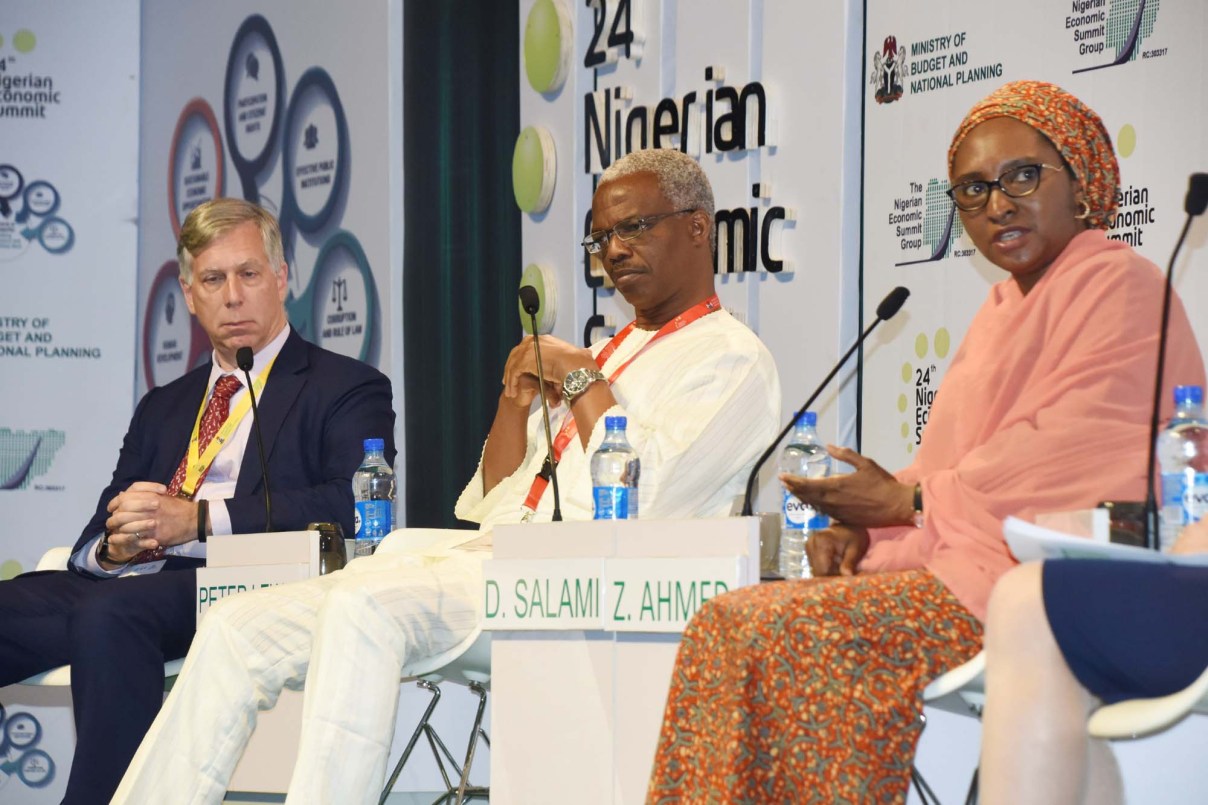US invests $24m to boost local enterprises, farming in Nigeria
October 23, 2018
PIND rolls out Good Governance Models at NESG
October 24, 2018The BusinessGreen Guide to the SDGs: SDG17 – Partnerships for the Goals
The SDGs end with a commitment to ‘strengthen the means of implementation and revitalize the global partnership for sustainable development’, but what role do businesses have to play?
Targets
Finance
17.1 Strengthen domestic resource mobilization, including through international support to developing countries, to improve domestic capacity for tax and other revenue collection.
17.1.1 Total government revenue as a proportion of GDP, by source.
17.1.2 Proportion of domestic budget funded by domestic taxes.
17.2 Developed countries to implement fully their official development assistance commitments, including the commitment by many developed countries to achieve the target of 0.7 per cent of ODA/GNI to developing countries and 0.15 to 0.20 per cent of ODA/GNI to least developed countries; ODA providers are encouraged to consider setting a target to provide at least 0.20 per cent of ODA/GNI to least developed countries.
17.2.1 Net official development assistance, total and to least developed countries, as a proportion of the Organization for Economic Cooperation and Development (OECD) Development Assistance Committee donors’ gross national income (GNI).
17.3 Mobilize additional financial resources for developing countries from multiple sources.
17.3.1 Foreign direct investments (FDI), official development assistance and South-South Cooperation as a proportion of total domestic budget.
17.3.2 Volume of remittances (in United States dollars) as a proportion of total GDP.
17.4 Assist developing countries in attaining long-term debt sustainability through coordinated policies aimed at fostering debt financing, debt relief and debt restructuring, as appropriate, and address the external debt of highly indebted poor countries to reduce debt distress.
17.4.1 Debt service as a proportion of exports of goods and services.
17.5 Adopt and implement investment promotion regimes for least developed countries.
17.5.1 Number of countries that adopt and implement investment promotion regimes for least developed countries.
TECHNOLOGY
17.6 Enhance North-South, South-South and triangular regional and international cooperation on and access to science, technology and innovation and enhance knowledge sharing on mutually agreed terms, including through improved coordination among existing mechanisms, in particular at the United Nations level, and through a global technology facilitation mechanism.
17.6.1 Number of science and/or technology cooperation agreements and programmes between countries, by type of cooperation.
17.6.2 Fixed Internet broadband subscriptions per 100 inhabitants, by speed.
17.7 Promote the development, transfer, dissemination and diffusion of environmentally sound technologies to developing countries on favourable terms, including on concessional and preferential terms, as mutually agreed.
17.7.1 Total amount of approved funding for developing countries to promote the development, transfer, dissemination and diffusion of environmentally sound technologies.
17.8 Fully operationalize the technology bank and science, technology and innovation capacity-building mechanism for least developed countries by 2017 and enhance the use of enabling technology, in particular information and communications technology.
17.8.1 Proportion of individuals using the Internet.
CAPACITY-BUILDING
17.9 Enhance international support for implementing effective and targeted capacity-building in developing countries to support national plans to implement all the sustainable development goals, including through North-South, South-South and triangular cooperation.
17.9.1 Dollar value of financial and technical assistance (including through North-South, South-South and triangular cooperation) committed to developing countries.
TRADE
17.10 Promote a universal, rules-based, open, non-discriminatory and equitable multilateral trading system under the World Trade Organization, including through the conclusion of negotiations under its Doha Development Agenda.
17.10.1 Worldwide weighted tariff-average.
17.11 Significantly increase the exports of developing countries, in particular with a view to doubling the least developed countries’ share of global exports by 2020.
17.11.1 Developing countries’ and least developed countries’ share of global exports.
17.12 Realize timely implementation of duty-free and quota-free market access on a lasting basis for all least developed countries, consistent with World Trade Organization decisions, including by ensuring that preferential rules of origin applicable to imports from least developed countries are transparent and simple, and contribute to facilitating market access.
17.12.1 Average tariffs faced by developing countries, least developed countries and small island developing States.
SYSTEMIC ISSUES
Policy and Institutional coherence
17.13 Enhance global macroeconomic stability, including through policy coordination and policy coherence.
17.13.1 Macroeconomic Dashboard.
17.14 Enhance policy coherence for sustainable development.
17.14.1 Number of countries with mechanisms in place to enhance policy coherence of sustainable development.
17.15 Respect each country’s policy space and leadership to establish and implement policies for poverty eradication and sustainable development.
Multi-stakeholder partnerships
17.15.1 Extent of use of country-owned results frameworks and planning tools by providers of development cooperation.
17.16 Enhance the global partnership for sustainable development, complemented by multi-stakeholder partnerships that mobilize and share knowledge, expertise, technology and financial resources, to support the achievement of the sustainable development goals in all countries, in particular developing countries.
17.16.1 Number of countries reporting progress in multi-stakeholder development effectiveness monitoring frameworks that support the achievement of the sustainable development goals.
17.17 Encourage and promote effective public, public-private and civil society partnerships, building on the experience and resourcing strategies of partnerships.
Data, monitoring and accountability
17.17.1 Amount of United States dollars committed to public-private and civil society partnerships.
17.18 By 2020, enhance capacity-building support to developing countries, including for least developed countries and small island developing States, to increase significantly the availability of high-quality, timely and reliable data disaggregated by income, gender, age, race, ethnicity, migratory status, disability, geographic location and other characteristics relevant in national contexts.
17.18.1 Proportion of sustainable development indicators produced at the national level with full disaggregation when relevant to the target, in accordance with the Fundamental Principles of Official Statistics.
17.18.2 Number of countries that have national statistical legislation that complies with the Fundamental Principles of Official Statistics.
17.18.3 Number of countries with a national statistical plan that is fully funded and under implementation, by source of funding.
17.19 By 2030, build on existing initiatives to develop measurements of progress on sustainable development that complement gross domestic product, and support statistical capacity-building in developing countries.
17.19.1 Dollar value of all resources made available to strengthen statistical capacity in developing countries.
17.19.2 Proportion of countries that (a) have conducted at least one population and housing census in the last 10 years; and (b) have achieved 100 per cent birth registration and 80 per cent death registration.
Progress to date
SDG17, the final sustainable development goal, is the goal that is the most clearly focused on traditional development issues. It pulls together a host of targets covering long-running concerns such as levels of overseas development aid, debt relief and tax reform, the need for capacity-building in poorer countries, trade reforms, and the challenges associated with obtaining accurate data.
As with most of the SDGs, performance against the various targets to date has been patchy and the UN warns “more needs to be done to accelerate progress”.
On the finance front, several key indicators are heading in the wrong direction. The ratio of tax revenue to GDP in the Least Developed Countries fell from a peak of 11.1 per cent in 2012 to 8.8 per cent in 2016. Countries in sub-Saharan Africa as a whole reported a similar trend falling from 14.9 per cent in 2006 to 10.7 per cent in 2016.
Overseas Development Aid (ODA) also continues to lag well behind international goals. Total funding from countries on the Development Assistance Committee (DAC) of the Organization for Economic Co-operation and Development (OECD) fell 0.6 per cent in 2016 to $146.6bn, while just five countries Denmark, Luxembourg, Norway, Sweden and the UK – met or exceeded the UN’s benchmark for ODA contributions of at least 0.7 per cent of gross national income (GNI). Overall ODA as a share of donors’ GNI stood at just 0.31 per cent.
Transfers from richer to poorer countries via migrant workers are also falling, largely thanks to tighter immigration rules in destination countries.
At the same time, despite high profile campaigns for debt relief for developing nations, the downward trend in debt service as a proportion of exports of goods and services has reversed over the past five years. It has now risen from a low of 3.5 per cent in 2011 to 8.6 per cent in 2016. As the UN notes, “the ability to sustainably service debts out of export earnings is crucial for countries most in need of resources for development”.
Funding for capacity building in developing countries has remained relatively stable, reaching $20.4bn in 2016, and there has been some progress on trade reforms – in 2016 the trade-weighted average preferential tariff rate applied to imports from LDCs was 7.9 per cent, a two-percentage points drop from the 2005 level.
However, at the same time there has been a stagnation in global trade since 2011 which has seen the expansion of developing countries share of overall trade stall. In fact, between 2014 and 2016 the share of world merchandise exports enjoyed by both developing and LDC regions fell.
Finally, gathering accurate data to measure progress against the SDGs remains a challenge in many areas. The UN notes that as of 2017 102 countries or areas were implementing national statistical plans, but even where plans are in place they are not always properly funded. In the least developed countries where the need to track progress is often most acute, data collection is typically at its weakest. Around 11 per cent of countries conducted no form of census in the past decade. In sub-Saharan Africa, only eight out of 53 countries have birth registration data that are at least 90 per cent complete, and only nine out of 53 countries have death registration data that are at least 75 per cent complete.
ALSO READ: Africa SDG Index and Dashboard Report 2018
Where does the UN get its money? A simple explanation of a complex system
FG, UNDP collaborate to mainstream SDGs in states, LGAs policies
Business implications
SDG17 is one of the easiest for businesses to ignore, given its initial focus on the aid policies and practices that are primarily determined by governments. However, the goal’s official title is Partnerships for the Goals and while the private sector only gets a passing mention it is clear it will be a critical partner in delivering on any and all of the SDGs.
There may be a huge debate raging about the value and effectiveness of aid funding, but done well effective financial support and capacity building should help open up major new markets by accelerating development in some of the world’s poorest countries.
More specifically, all the targets requiring technology transfer and capacity building imply the opening up of new and sustainable markets in developing and least developed economies.
Target 17.7 and its promise to promote the development, transfer, dissemination, and diffusion of environmentally sound technologies to developing countries on favourable terms, implies a major boost to the expanding global market for clean technologies and green services. Similarly, target 17.8 and the promise to enhance the “use of enabling technology, in particular information and communications technology” suggests an ambitious plan to rapidly extend the global digital economy. Meanwhile, the wider pledge to deliver long promised trade reforms to lower trade barriers for poorer nations should also provide a fillip for many businesses.
The wide-ranging targets to “enhance policy coherence for sustainable development”, “enhance the global partnership for sustainable development”, and “encourage and promote effective public, public-private and civil society partnerships” could be interpreted in a number of ways, but taken at face value they reiterate the general commitment to make the SDGs central to government policy making and underscore the crucial role businesses and civil society will have in ensuring their delivery.
Business risks
There are clear businesses risks associated with a failure to deliver the kind of effective ODA strategies that drive development, bolster resilience, and secure economic growth in developing countries. Equally, a failure to build capacity and improve governance will also serve to undermine growth prospects in emerging markets.
The long-running saga of global trade talks highlights the difficulties and risks associated with any form of trade reform, which inevitably carries with it the risks of new trade barriers and the potential creation of winners and losers. In an era of growing protectionism there is always the risk that efforts to liberalise trade and remove trade barriers for poorer nations will be seen as a threat to farmers and industries in industrialised economies.
Similarly, the targets covering technology transfer may promise to open up new markets, but they also play into debates about intellectual property protection and the extent to which companies have an obligation to relax copyright rules or forgo profits to help aid development.
More broadly, the calls for greater co-operation between the public and private sector and other stakeholders are well intentioned, but they are not without risks. Companies that fail to tread carefully risk knowledge sharing initiatives straying into areas where they give up competitive advantage, while public and private partnerships and more general co-operation between business and governments can fuel accusations of corporate lobbying and undue influence, even if the end goal is sustainable development for all.
Business opportunities
Beyond the economic growth and sustainable development that should flow from effective overseas aid and capacity building, SDG17 offers a host of business opportunities.
For example, one of the indicators for SDG17.6, which covers technology co-operation, is the number of fixed Internet broadband subscriptions per 100 inhabitants, by speed. Access to fast broadband and mobile coverage is now one of the primary mechanisms for unlocking new commercial opportunities, and that trend will only accelerate as innovative online finance, health and energy services evolve for developing economy markets.
Other capacity building and technology transfer arrangements similarly imply both fresh infrastructure investment and the emergence of new markets as businesses step up to provide critical services.
Specific opportunities for the clean tech sector are on offer thanks to SDG17.7 and its pledge to “promote the development, transfer, dissemination and diffusion of environmentally sound technologies to developing countries on favourable terms, including on concessional and preferential terms, as mutually agreed”. It may not refer specifically to on-going global efforts to agree a free trade deal for clean tech and green services, but it suggests there remains widespread backing for stimulating green trade.
More broadly, SDG17 reasserts government’s commitment to free trade, even if the rise of Trumpism since the SDGs were agreed has transformed the political landscape. Were long-promised trade liberalisation to be delivered it would serve to cut costs and boost trade opportunities for all businesses, even if such a move led to significant disruption for some industries.
The promise of enhanced global macroeconomic stability and sustainable development policy coherence may be vague, but it can only benefit a business community that increasingly recognises that it enjoys the best long term prospects in stable societies with credible sustainable development paths.
The call for a partnership approach to drive sustainable development and better links between government, business, and civil society provides businesses with a valuable opportunity to contribute to effective policy development and underscore their commitment to the societies in which they operate, as well as the wider SDGs.
Finally, improvements in access to development data and the advance of reliable censuses can only help business planning and investments in much the same way as it helps shape government strategy.
Culled From – BusinessGreen








